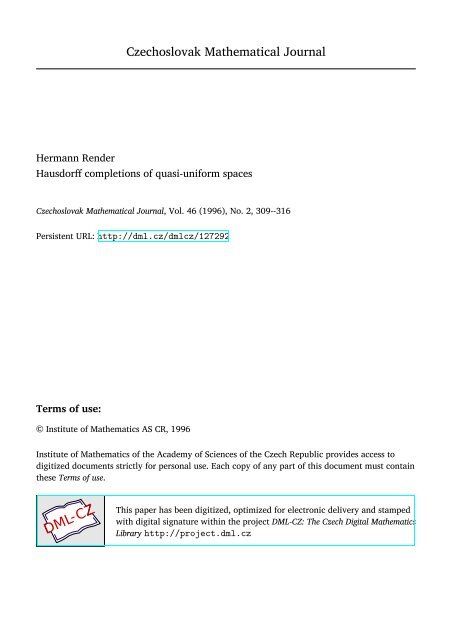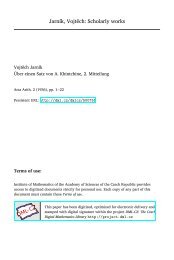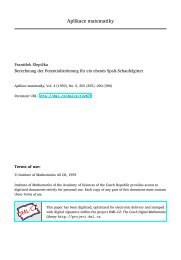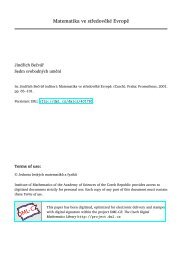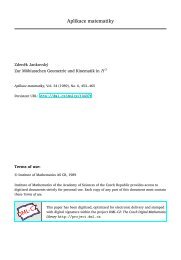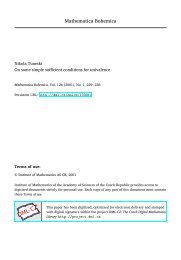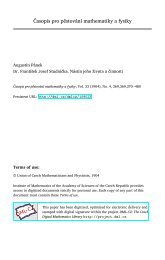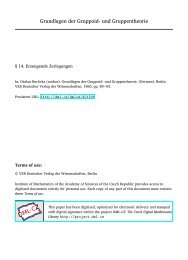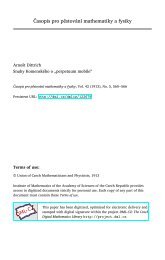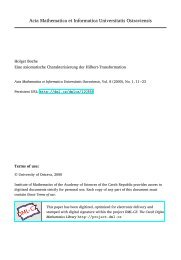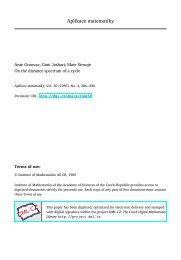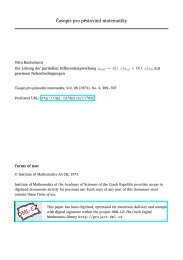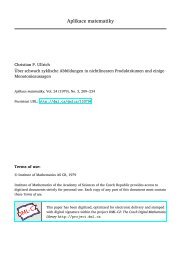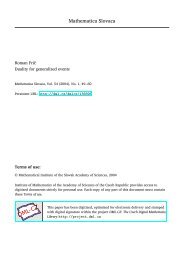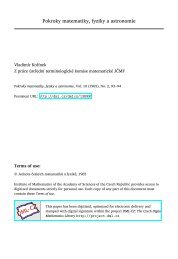Hausdorff completions of quasi-uniform spaces
Hausdorff completions of quasi-uniform spaces
Hausdorff completions of quasi-uniform spaces
Create successful ePaper yourself
Turn your PDF publications into a flip-book with our unique Google optimized e-Paper software.
Hermann Render<br />
Czechoslovak Mathematical Journal<br />
<strong>Hausdorff</strong> <strong>completions</strong> <strong>of</strong> <strong>quasi</strong>-<strong>uniform</strong> <strong>spaces</strong><br />
Czechoslovak Mathematical Journal, Vol. 46 (1996), No. 2, 309--316<br />
Persistent URL: http://dml.cz/dmlcz/127292<br />
Terms <strong>of</strong> use:<br />
© Institute <strong>of</strong> Mathematics AS CR, 1996<br />
Institute <strong>of</strong> Mathematics <strong>of</strong> the Academy <strong>of</strong> Sciences <strong>of</strong> the Czech Republic provides access to<br />
digitized documents strictly for personal use. Each copy <strong>of</strong> any part <strong>of</strong> this document must contain<br />
these Terms <strong>of</strong> use.<br />
This paper has been digitized, optimized for electronic delivery and stamped<br />
with digital signature within the project DML-CZ: The Czech Digital Mathematics<br />
Library http://project.dml.cz
Czechoslovak Mathematical Journal, 46 (121) 1996, Praha<br />
HAUSDORFF COMPLETIONS OF QUASI-UNIFORM SPACES<br />
HERMANN RENDER, Duisburg<br />
(Received June 28, 1994)<br />
INTROCTUDION<br />
It is an old question in the theory <strong>of</strong> <strong>quasi</strong>-<strong>uniform</strong> <strong>spaces</strong> which <strong>quasi</strong>-<strong>uniform</strong>ities<br />
have a T2-completion, cf. [6, p. 71]. In [14] the methods <strong>of</strong> nonstandard analysis<br />
have been used to derive necessary and sufficient conditions for the existence <strong>of</strong> a<br />
T2-completion.<br />
In this paper we give a standard pro<strong>of</strong> <strong>of</strong> the following sufficient condition given<br />
in [14]: if (X, Y) is a <strong>quasi</strong>-<strong>uniform</strong> T2-space containing a compatible <strong>uniform</strong>ity tf/<br />
then X possesses a T2-completion. More general, we prove here that Y possesses<br />
a T2-completion if and only if any compatible <strong>quasi</strong>-<strong>uniform</strong>ity W D Y possesses a<br />
T2-completion. It follows from the methods <strong>of</strong> pro<strong>of</strong> that the finest <strong>uniform</strong>ity and<br />
the finest <strong>quasi</strong>-<strong>uniform</strong>ity on a completely regular T2-space A" have a T2-completion<br />
exactly <strong>of</strong> the cardinality <strong>of</strong> the Stone-Cech compactification 0(X). A striking consequence<br />
<strong>of</strong> our main result is that every non-compact <strong>uniform</strong> T2-space has a T2completion<br />
which is different from the usual <strong>uniform</strong> completion. All these results<br />
are contained in the first section.<br />
It is a matter <strong>of</strong> fact that the construction <strong>of</strong> the T2-completion in section 1 does<br />
not yield T2-compactifications (except when the remainder is finite). In the second<br />
section we investigate a modified construction which is useful for locally compact<br />
<strong>spaces</strong>. In this case we can prove that every topological T2-compactification satisfying<br />
a certain natural condition can be considered as a <strong>quasi</strong>-<strong>uniform</strong> T2-compactification.<br />
309
1. ^"COMPLETIONS.<br />
A completion <strong>of</strong> a <strong>quasi</strong>-<strong>uniform</strong> space (A", U) is a complete <strong>quasi</strong>-<strong>uniform</strong> space<br />
(V y/ / ) that has a dense subspace <strong>quasi</strong>-isomorphic to (X/'U). The induced topol<br />
ogy <strong>of</strong> a <strong>quasi</strong>-<strong>uniform</strong> space (X,Y) is denoted by T(T). Recall that two <strong>quasi</strong>-<br />
<strong>uniform</strong>ities are compatible if they induce the same topology A <strong>quasi</strong>-<strong>uniform</strong>ity '/''<br />
is point-symmetric if for each V G V, x G X there exists a symmetric U G 'U such<br />
that U[x] C V[x\. Throughout the paper we assume the following basic construction:<br />
1.1 Definition. Let (X, '/ ) be a <strong>quasi</strong>-<strong>uniform</strong> space and °?/ be a <strong>quasi</strong>-<br />
<strong>uniform</strong>ity on a larger set S such that the restriction °?/\X is a compatible weaker<br />
<strong>quasi</strong>-<strong>uniform</strong>ity than y. We define a filter f 7 ?/ on 5 x S in the following way: for<br />
V G y,U G °?/ define<br />
vu := U (M x r N) u U iv) x (M u M n *))•<br />
xex yes\x<br />
By definition, fV is the filter generated by Vu with V G /\ U G °?/.<br />
1.2 Proposition. /V i*> a <strong>quasi</strong>-<strong>uniform</strong>ity on S finer than tf/, in particular<br />
r( y //)Cr(%).<br />
Pro<strong>of</strong>. It is easy to see that /
for all F G & and U e °?/. In the case <strong>of</strong> z G X we obtain FnVu[z]^0 since °?/\X<br />
and V are compatible. If z G S \ X then obviously F n Vt/[^] / 0.<br />
In the second case there exists F0 G ^ with F0 D A" = 0. Since & is a TV-Cauehy<br />
filter there exists F G J^" with F C Vt/[y] for some y G S. But y can not be in X;<br />
otherwise we would have F C V[y] and therefore F D F0 C V[y] fl F0 C X n F0 = 0,<br />
a contradiction. Since H £ A" we obtain F C U[y] D X U {g}. Hence we obtain<br />
F H F0 = {y}. Thus J^" is the ultrafilter consisting <strong>of</strong> all subsets B C S with y G 13.<br />
Therefore ^ converges to u and the pro<strong>of</strong> is complete. •<br />
1.4 Remark. A short review <strong>of</strong> the pro<strong>of</strong> shows that (S, "/
Vu[y] — {y} U (U[y] n X) is different from {y} since y is in the T(°?/)-closure <strong>of</strong> X.<br />
It follows that y
1.12 Theorem. Let (X, V) be a precompact <strong>quasi</strong>-<strong>uniform</strong> space and (S, 6 ?/) be<br />
a complete <strong>Hausdorff</strong> space such that °?/\X C V are compatible. Then the following<br />
statements are equivalent for V
The last proposition has an interesting consequence: Let (X, Y) be a precompact<br />
T2-<strong>uniform</strong>ity and let (5, °?/) be the (unique) <strong>uniform</strong> <strong>Hausdorff</strong> completion <strong>of</strong> '/'.<br />
Then (S,Y^(S)) is precompact and <strong>Hausdorff</strong>, cf. Proposition 1.2 and 2.3. If 5 is<br />
complete then 5 is a compact <strong>Hausdorff</strong> space and therefore A" is locally compact by<br />
Proposition 2.2. Hence an analogue <strong>of</strong> Theorem 1.3 for /%(5) can only be expected<br />
for locally compact <strong>spaces</strong>. More precisely, we prove<br />
2.4 Theorem. If (X,T(Y)) is open in (S,T(°?/)) and (S,°?/) is a complete <strong>quasi</strong>-<br />
<strong>uniform</strong>ity such that °?/\X C Y are compatible then 5 is complete with respect to<br />
%{S).<br />
Pro<strong>of</strong>. Let & be a TV(5)-Cauchy filter. Case 1 in the pro<strong>of</strong> <strong>of</strong> 1.3 can be<br />
treated as in 1.3. Hence we can assume that there exists Fo £ ^ such that FQDX = 0.<br />
It is clear that & is as well a ^/-Cauchy filter. Hence there exists an adherent point<br />
go C 5 by ^-completeness. It suffices to show that y{) is an adherent point <strong>of</strong> J^.<br />
At first we consider the case y0 G 5 \ X. Let Vu(S) — U[go] be a neighborhood <strong>of</strong><br />
Ho and let F G ^. Then F n V^i(S)[y0] = Fn U[y0] ^ 0.<br />
In the other case we have IJQ G X. Since (X, T(Y)) is open in (5, T( 0 ?/)) we can<br />
find U G f/ such that U[Ho] C X. Hence Fo H U[y0] C Fo H A" = 8, a contradiction.<br />
Hence yo C X is impossible. •<br />
2.5 Theorem. If (X, Y) is locally compact and (S, °?/) is compact <strong>Hausdorff</strong> such<br />
that °?/\X C y are compatible then S is compact with respect to Y^/(S).<br />
Pro<strong>of</strong>. Let (Tx)xes be an Y
<strong>uniform</strong>ity YK on K such that (A~, YK) is a <strong>quasi</strong>-<strong>uniform</strong> T2-compactincation <strong>of</strong><br />
(X,'Y). Since every compact IVspace has a (unique) compatible <strong>uniform</strong>ity °?/(K)<br />
which is the smallest compatible <strong>quasi</strong>-<strong>uniform</strong>ity we obtain the following necessary<br />
condition for our problem:<br />
(*) The restriction <strong>of</strong> the associated <strong>uniform</strong>ity °?/(K) to the subspace X is smaller<br />
than or equal to Y.<br />
It is shown in [6, p. 69] that (*) is also sufficient provided that Y is totally bounded.<br />
We show that (*) is sufficient provided that X is locally compact:<br />
2.6 Theorem. Let (X, Y) be a locally compact <strong>quasi</strong>-<strong>uniform</strong> <strong>Hausdorff</strong> space<br />
and K a topological compactitication <strong>of</strong> (X,T(Y)). Then K is a <strong>quasi</strong>-<strong>uniform</strong> T2compactification<br />
<strong>of</strong> (X,Y) for a <strong>quasi</strong>-<strong>uniform</strong>ity Y on K iff (*) holds.<br />
Pro<strong>of</strong>. Suppose that (*) holds. Define °?/ := °?/(K) and S := K. Now<br />
Theorem 2.5 shows that (A~, Y^/(S)) is a compact space which contains (X,'Y) as a<br />
<strong>quasi</strong>-<strong>uniform</strong> dense subspace. •<br />
References<br />
[1] J. W. Carlson and T. L. Hicks: On completeness in <strong>quasi</strong>-<strong>uniform</strong> <strong>spaces</strong>. J. Math.<br />
Anal. Appl. 34 (1971), 618-627.<br />
[2] D. Doitchinov: A concept <strong>of</strong> completeness <strong>of</strong> <strong>quasi</strong>-<strong>uniform</strong> <strong>spaces</strong>. Topology Appl. 38<br />
(1991), 205-217.<br />
[3] P. Fletcher and W. Hunsaker: Symmetry conditions in terms <strong>of</strong> open sets. Topology<br />
Appl. ^5(1992), 39-47.<br />
[4] P. Fletcher and W. Hunsaker: Uniformly regular <strong>quasi</strong>-<strong>uniform</strong>ities. Topology Appl. 37<br />
(1990), 285-291.<br />
[5] P. Fletcher and W. Hunsaker: Completeness using pairs <strong>of</strong> filters. Topology Appl. 44<br />
(1992), 149-155.<br />
[G] P. Fletcher and W. F. Lindgrcn: Quasi-<strong>uniform</strong> <strong>spaces</strong>. Marcel Dekker. New York, 1982.<br />
[7] P. Fletcher and W. F. Lindgrcn: Compactifications <strong>of</strong> totally bounded <strong>quasi</strong>-<strong>uniform</strong><br />
<strong>spaces</strong>. Glasgow Math. J. 28 (1986), 31-36.<br />
[8] P. Fletcher and W. F. Lingren: (7-complete <strong>quasi</strong>-<strong>uniform</strong> <strong>spaces</strong>. Arch. Math. 50(1978),<br />
175-180.<br />
[9] P. Fletcher and W. F. Lindgren: A construction <strong>of</strong> the pair completion <strong>of</strong> a <strong>quasi</strong>-<strong>uniform</strong><br />
space. Canad. Math. Bull. 21 (1978), 53-59.<br />
[10] II.-P. Kiinzi: A regular space without a <strong>uniform</strong>ly regular <strong>quasi</strong>-<strong>uniform</strong>ity. Monatshefte<br />
Math. 770(1990), 115-116.<br />
[11] II.-P. Kiinzi: Nonsymmetric topology. Szekszard, Hungary, To appear in the Proceedings<br />
<strong>of</strong> the conference "Colloquium on Topology 1993".<br />
[12] II.-P. Kiinzi and P. Fletcher: Extension properties induced by complete <strong>quasi</strong><strong>uniform</strong>ities.<br />
Pacific J. Math. 120 (1985), 357-384.<br />
[13] II.-P. Kiinzi, M. Mrsevic, I. L. Reilly, M. K. Vam.ananiurthy: Convergence, precompactness<br />
and symmetry in <strong>quasi</strong>-<strong>uniform</strong> <strong>spaces</strong>. Math. Japonica ^7(1992), 35-52.<br />
[14] II. Render: Nonstandard methods <strong>of</strong> completing <strong>quasi</strong>-<strong>uniform</strong> <strong>spaces</strong>. Topology Appl.<br />
62 (1995), 101-125.<br />
315
[15] H. Render: Generalized <strong>uniform</strong> <strong>spaces</strong> and Applications to function <strong>spaces</strong>. Submitted.<br />
[16] S. Salbany and T. Todorov: Nonstandard and standard compactifications <strong>of</strong> ordered<br />
topological <strong>spaces</strong>. Topology Appl. ^7(1992), 35-52.<br />
[17] M. B. Smyth: Stable compactification I. J. London Math. Soc. 45 (1992), 321-340.<br />
[18] A. J. Ward: A generalization <strong>of</strong> almost compactness, with an associated generalization<br />
<strong>of</strong> completeness. Czechoslovak Math. J. 25 (100) (1975), 514-530.<br />
Author's address: Fachbereich 11 Mathematik, Gerhard-Mercator-Universitat Duisburg,<br />
Lotharstr. 65, D-47057 Duisburg, Federal Republic <strong>of</strong> Germany<br />
316


